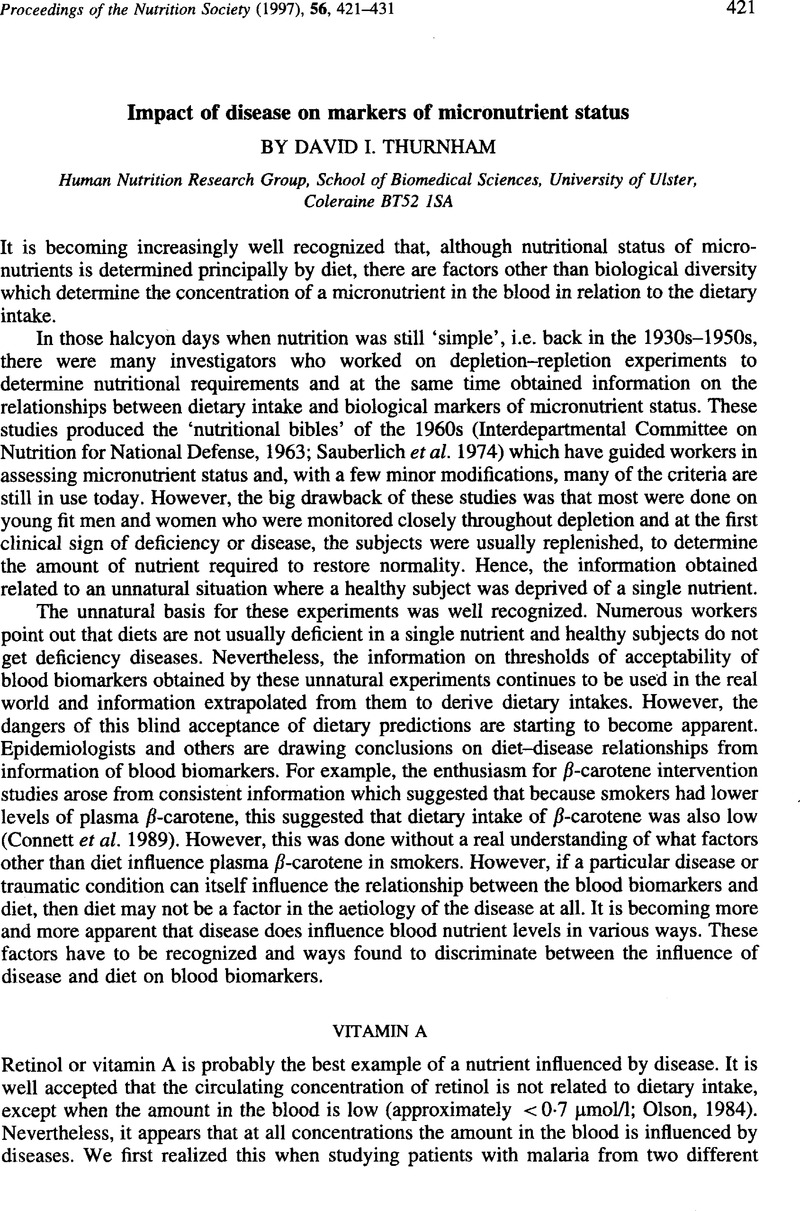Crossref Citations
This article has been cited by the following publications. This list is generated based on data provided by Crossref.
Adelekan, D. A.
Adeodu, O. O.
and
Thurnham, D. I.
1997.
Comparative effects of malaria and malnutrition on plasma concentrations of antioxidant micronutrients in children.
Annals of Tropical Paediatrics,
Vol. 17,
Issue. 3,
p.
223.
Thurnham, David I
Northrop-Clewes, Christine A
Chopra, Mridula
and
Drewnowski, Adam
1998.
Biomarkers of vegetable and fruit intakes.
The American Journal of Clinical Nutrition,
Vol. 68,
Issue. 3,
p.
756.
Thurnham, David I.
and
Northrop-Clewes, Christine A.
1999.
Optimal nutrition: vitamin A and the carotenoids.
Proceedings of the Nutrition Society,
Vol. 58,
Issue. 2,
p.
449.
Enwonwu, CO
Falkler, WA
Idigbe, EO
and
Savage, KO
1999.
Noma (cancrum oris): questions and answers.
Oral Diseases,
Vol. 5,
Issue. 2,
p.
144.
J. Geerling, R. W. Stockbrügger, R., B.
1999.
Nutrition and Inflammatory Bowel Disease: An Update.
Scandinavian Journal of Gastroenterology,
Vol. 34,
Issue. 230,
p.
95.
Anderson, Annie S
Maher, Linda
Ha, Tom K
Cooney, Josephine
Eley, Susan
Martin, Marilyn
Vespasiani, Giacomo
Bruni, Mauro
and
Lean, Michael EJ
1999.
Evaluation of a bar-code system for nutrient analysis in dietary surveys.
Public Health Nutrition,
Vol. 2,
Issue. 4,
p.
579.
Bates, Christopher J
Walmsley, Catherine M
Prentice, Ann
and
Finch, Steven
1999.
Use of medicines by older people in a large British national survey, and their relation to vitamin status indices.
Public Health Nutrition,
Vol. 2,
Issue. 1,
p.
15.
Corish, Clare A.
and
Kennedy, Nicholas P.
2000.
Protein–energy undernutrition in hospital in-patients.
British Journal of Nutrition,
Vol. 83,
Issue. 6,
p.
575.
Solomons, Noel W.
and
Keusch, Gerald T.
2000.
Nutrition and Immunology.
p.
181.
Stephensen, Charles B
and
Gildengorin, Ginny
2000.
Serum retinol, the acute phase response, and the apparent misclassification of vitamin A status in the third National Health and Nutrition Examination Survey.
The American Journal of Clinical Nutrition,
Vol. 72,
Issue. 5,
p.
1170.
Enwonwu, C.O.
Falkler, W.A.
and
Idigbe, E.O.
2000.
Oro-Facial Gangrene (Noma/Cancrum Oris): Pathogenetic Mechanisms.
Critical Reviews in Oral Biology & Medicine,
Vol. 11,
Issue. 2,
p.
159.
McMillan, Donald C
Sattar, Naveed
Talwar, Dinesh
O’Reilly, Denis St.J
and
McArdle, Colin S
2000.
Changes in micronutrient concentrations following anti-inflammatory treatment in patients with gastrointestinal cancer.
Nutrition,
Vol. 16,
Issue. 6,
p.
425.
Payne, A.
2001.
Nutrition and diet in the clinical management of multiple sclerosis.
Journal of Human Nutrition and Dietetics,
Vol. 14,
Issue. 5,
p.
349.
Stephensen, Charles B
Franchi, Luis Miguel
Hernandez, Herminio
Campos, Miguel
Colarossi, Ana
Gilman, Robert H
and
Alvarez, Jose O
2002.
Assessment of vitamin A status with the relative-dose-response test in Peruvian children recovering from pneumonia.
The American Journal of Clinical Nutrition,
Vol. 76,
Issue. 6,
p.
1351.
Northrop-Clewes, C.A.
and
Thurnham, D.I.
2002.
The Nutrition Handbook for Food Processors.
p.
34.
Blanck, Heidi Michels
Bowman, Barbara A.
Cooper, Gerald R.
Myers, Gary L.
and
Miller, Dayton T.
2003.
Laboratory Issues: Use of Nutritional Biomarkers.
The Journal of Nutrition,
Vol. 133,
Issue. 3,
p.
888S.
Fain, Olivier
Pariés, Jacques
Jacquart, Benoı̂t
Le Moël, Giséle
Kettaneh, Adrien
Stirnemann, Jérôme
Héron, Célia
Sitbon, Muriel
Taleb, Chérifa
Letellier, Edouard
Bétari, Bouchra
Gattegno, Liliane
and
Thomas, Michel
2003.
Hypovitaminosis C in hospitalized patients.
European Journal of Internal Medicine,
Vol. 14,
Issue. 7,
p.
419.
Northrop-Clewes, C.A.
and
Thurnham, D.I.
2004.
Functional Foods, Ageing and Degenerative Disease.
p.
681.
Thurnham, David I.
2004.
An overview of interactions between micronutrients and of micronutrients with drugs, genes and immune mechanisms.
Nutrition Research Reviews,
Vol. 17,
Issue. 2,
p.
211.
Thurnham, David I.
and
Northrop-Clewes, Christine A.
2004.
Diet and Human Immune Function.
p.
35.



